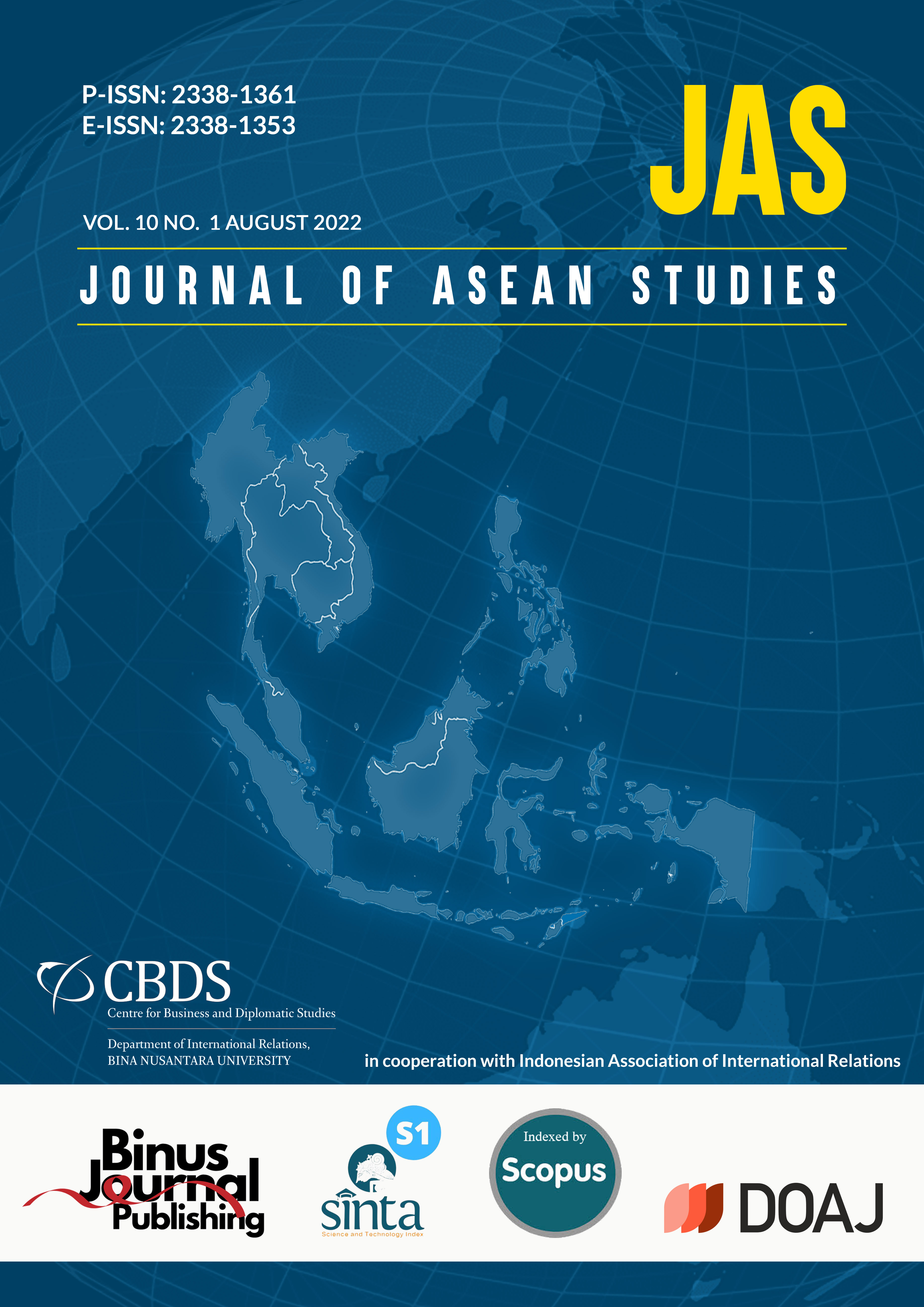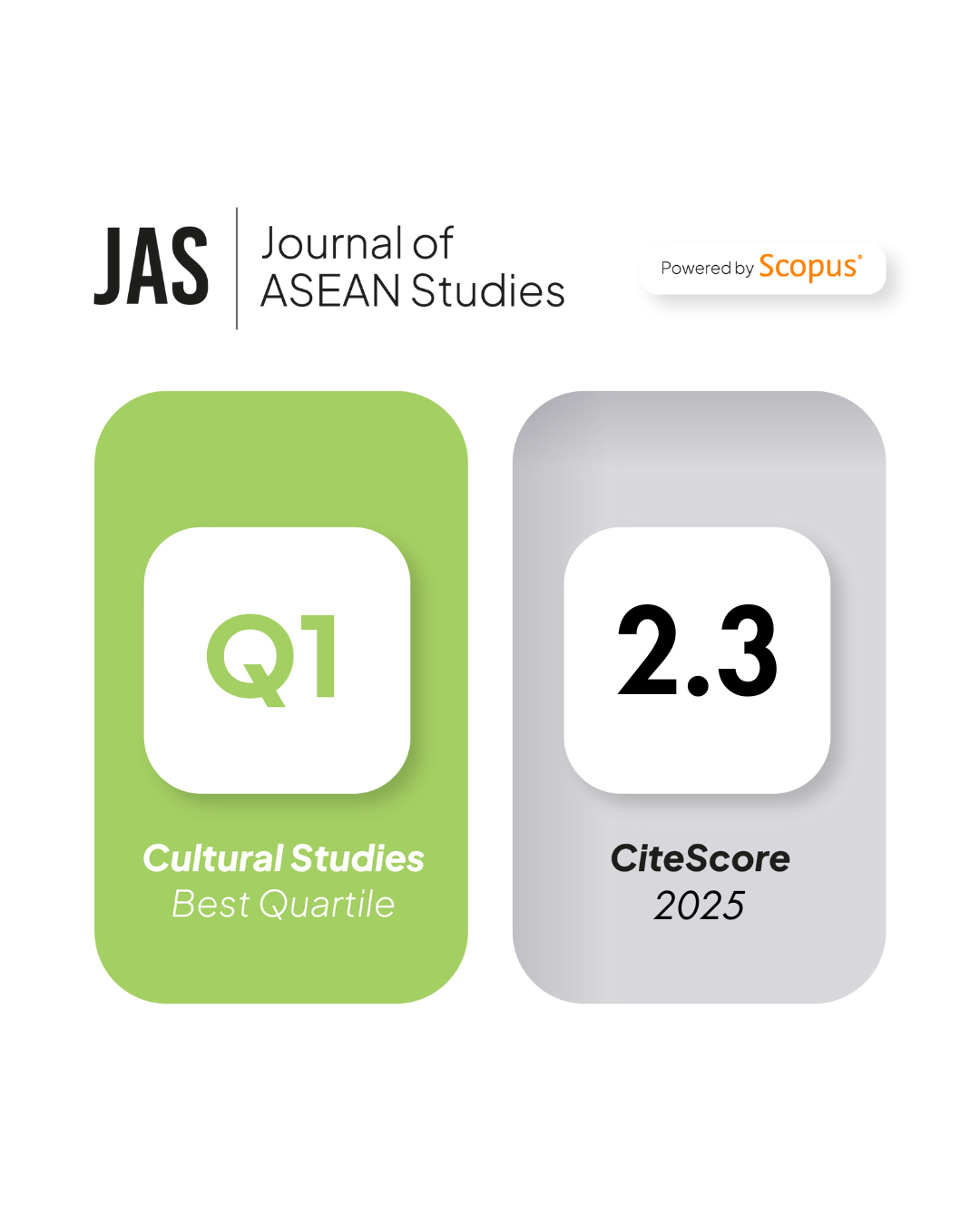Conflict Potential of the Rohingya People in Bangladesh and Beyond
DOI:
https://doi.org/10.21512/jas.v10i1.8215Keywords:
Rohingya, Myanmar, Displacement, Conflict, BangladeshAbstract
The article addresses how Myanmar's Rohingya conflict could generate a potential for conflict within the borders of Bangladesh and beyond. The conflict in Myanmar due to the Rohingyas being deprived of their national citizenship had led to the mass exodus in 2017 to Bangladeshi land and the subsequent conflict in the host place. It was referred to various situations, including disputes, killing, abduction, and tensions between the refuges and host people. Based on existing theories of ‘exporting conflict’ such as displacing conflict and spill over effect of ethnic conflict, the article attempted to show how the Rohingya conflict originated in Myanmar lead to serious conflicts taking place in Bangladesh. The theoretical basis proposed in the article had been supported with reliable secondary sources of information and published expert opinions on the contemporary situation of the temporary Rohingya settlements in Bangladesh with regards to their sheltering, refugee management, and progress towards their repatriation process to Myanmar. The article argued that Myanmar's civil conflict had spilled over into Bangladesh's borders due to a sequence of events starting from when Myanmar's civil conflict erupted from its National Citizenship Act. Findings suggest that the Myanmar conflict has been displaced to Bangladesh through many refugee settlements that puts Bangladesh's population in midst of a host of issues concerning livelihood, safety, and security. This has been done while touching upon Bangladesh's position as a host country to millions of Rohingya refugees and shouldering issues already stemming from the temporary shelter of Rohingya people within its borders.
References
Adhikari, P. (2012). Conflict-induced displacement, understanding the causes of flight. American Journal of Political Science, 57(1), 82–89. https://doi.org/10.1111/j.1540-5907.2012.00598.x
Alam, J. (2019). The current Rohingya crisis in Myanmar in historical perspective. Journal of Muslim Minority Affairs, 39(1), 1-25. https://doi.org/10.1080/13602004.2019.1575560
Alam, S. (2019, August 24). INFOGRAPHIC - Top Rohingya-hosting countries. Anadolu Agency. https://www.aa.com.tr/en/asia-pacific/infographic-top-rohingya-hosting-countries/1563674
Ansar, A. (2020). The unfolding of belonging, exclusion and exile: A reflection on the history of Rohingya refugee crisis in Southeast Asia. Journal of Muslims Minority Affairs, 40(3), 441-456. https://doi.org/10.1080/13602004.2020.1819126
Azad, G. M. A. K. (2021, November 11). Joint Webinar on The Rohingya Exodus in Bangladesh: Regional and Global Security Implications [Video]. YouTube. https://www.youtube.com/watch?v=XWBgLGXUxKg
Bakali, N. & Wasty, S. (2020). Identity, social mobility, and trauma: Post-conflict educational realities for survivors of the Rohingya genocide. Religions, 11(5), 241. https://doi.org/10.3390/rel11050241
Banerjee, S. (2019, March 15). Drug trafficking and Rohingya refugees in Bangladesh. Observer Research Foundation. https://www.orfonline.org/expert-speak/drug-trafficking-and-rohingya-refugees-in-bangladesh-49005/
Banerjee, S. (2020). From Cox’s Bazar to Bhasan Char: An assessment of Bangladesh’s relocation plan for Rohingya refugees. Kolkata: Observer Research Foundation. https://www.orfonline.org/wp-content/uploads/2020/05/ORF_IssueBrief_357_BhasanChar.pdf
Begum, I. A., Raiyana, Z., Azad, M. A., Huda, M. S., Anwar, A., Khalil, M. E., & Rizwan, A. A. (2021). Disease pattern of geriatric people of the host community in Cox’s Bazar, Bangladesh. Journal of Medical Research and Surgery, 2(6) 1-4. https://doi.org/10.52916/jmrs214062
Belkania, B. (2020). How do civil wars impact international peace and security? Examples from Asia and Africa. Free University Journal of Asian Studies, 2. https://journals.org.ge/index.php/asianstudies/article/view/37
Bhatia, A., Mahmud, A., Fuller, A., Shin, R., Rahman, A., Shatil, T., . . . Balsari, S. (2018). The Rohingya in Cox’s Bazar: When the Stateless Seek Refuge. Health and Human Rights, 20(2), 105–122.
Bhattacharya, S. & Biswas, B. (2020). International norms of asylum and burden-sharing: A case study of Bangladesh and the Rohingya refugee population. Journal of Refugee Studies, 34(4), 3734-3751. https://doi.org/10.1093/jrs/feaa122
Bosker, M. & de Ree, J. (2014). Ethnicity and the spread of civil war. Journal of Development Economics, 108, 206-221. https://doi.org/10.1016/j.jdeveco.2014.02.002
Bremner, L. (2020). Sedimentary logics and the Rohingya refugee camps in Bangladesh. Political Geography, 77. https://doi.org/10.1016/j.polgeo.2019.102109
Carmignani, F. & Kler, P. (2016, March). The geographical spillover of armed conflict in Sub-Saharan Africa. Economic Systems, 40(1), 109-119. https://doi.org/10.1016/j.ecosys.2015.08.002
Chowdhury, A. R. (2019). International-domestic linkages in a developing-country context: the case of the Rohingyas in Bangladesh. Policy Studies, 40(3-4), 303-319. https://doi.org/10.1080/01442872.2018.1557623
Chowdhury, M. A., Billah, S. M., Karim, F., Khan, A. N., Islam, S., & Arifeen, S. E. (2018). Demographic Profiling and Needs Assessment of Maternal and Child Health (MCH) Care for the Rohingya Refugee Population in Cox’s Bazar, Bangladesh. icddr,b. Dhaka: Maternal and Child Health Division. http://dspace.icddrb.org/jspui/bitstream/123456789/9067/2/Special%20Report%20153.pdf
Crabtree, K. (2010). Economic challenges and coping mechanisms in protracted displacement: A case study of the Rohingya refugees in Bangladesh. Journal of Muslim Mental Health, 5(1), 41-58. https://doi.org/10.1080/15564901003610073
Dal, E. P. (2016). Impact of the transnationalization of the Syrian civil war on Turkey: conflict spillover cases of ISIS and PYD-YPG/PKK. Cambridge Review of International Affairs, 29(4), 1396-1420. https://doi.org/10.1080/09557571.2016.1256948
Davenport, C., Moore, W., & Poe, S. (2003). Sometimes you just have to leave: Domestic threats and forced migration. International Interactions, 29(1), 27-55. https://doi.org/10.1080/03050620304597
Dunne, J. P. & Tian, N. (2019). Costs of civil war and fragile states in Africa. Review of Development Economics, 23(3), 1220-1237. https://doi.org/10.1111/rode.12612
Edwards, S. (2009). The Chaos of Forced Migration: A Means of Modeling Complexity for Humanitarian Ends. Saarbr¨ucken, Germany: VDM Verlag.
Faruque, A. S., Khan, A. I., Islam, S. M., Nahar, B., Hossain, M. N., Widiati, Y., . . . Ahmed, T. (2021). Diarrhea treatment center (DTC) based diarrheal disease surveillance in settlements in the wake of the mass influx of forcibly displaced Myanmar national (FDMN) in Cox’s Bazar, Bangladesh, 2018. PLOS One, 16(8), 1-17. https://doi.org/10.1371/journal.pone.0254473
Faruque, A. S., Khan, A. I., Nahar, B., Islam, S. M., Hossain, M. N., Abdullah, S. A., . . . Va, M. (2021). Cholera outbreak in Forcibly Displaced Myanmar National (FDMN) from a small population segment in Cox’s Bazar, Bangladesh, 2019. PLOS Neglected Tropical Diseases, 15(9), 1-14. https://doi.org/10.1371/journal.pntd.0009618
Farzana, K. F. (2021). State and violence in Burma/Myanmar: The Rohingya crisis and its implication for South and South-East Asia. In M. Mio, K. Nakamizo, & T. Fujikura (Eds.), The Dynamics of Conflict and Peace in Contemporary South Asia (pp. 55-73). London: Routledge.
Faye, M. (2021). A forced migration from Myanmar to Bangladesh and beyond: humanitarian response to Rohingya refugee crisis. Journal of International Humanitarian Action, 6, 1-7. https://doi.org/10.1186/s41018-021-00098-4
Hossain, A. N. (2021, October). Sustainable development and livelihoods of Rohingya refugees in Bangladesh: The effects. International Journal of Sustainable Development and Planning, 16(6), 1141-1152. https://doi.org/10.18280/ijsdp.160615
Imtiaz, S. (2018). Ecological impact of Rohingya refugees on forest resources: remote sensing analysis of vegetation cover change in Teknaf Peninsula in Bangladesh. Ecocycles, 4(1), 16-19. https://doi.org/10.19040/ecocycles.v4i1.89
Islam, M. M. & Nuzhath, T. (2018). Health risks of Rohingya refugee population in Bangladesh: A call for global attention. Journal of Global Health, 8(2). https://doi.org/10.7189/jogh.08.020309
Islam, M. N., Inan, T. T., & Islam, A. K. (2020). COVID-19 and the Rohingya Refugees in Bangladesh: The Challenges and Recommendations. Asia Pacific Journal of Public Health, 32(5), 283-284. https://doi.org/10.1177/1010539520932707
Islam, M. R., Islam, M. T., Alam, M. S., Hussain, M., & Haque, M. M. (2021). Is Bhasan Char Island, Noakhali district in Bangladesh a sustainable place for the relocated Rohingya displaced people? An empirical study. SN Social Sciences, 277. https://doi.org/10.1007/s43545-021-00281-9
Karin, S., Chowdhury, M. A., Hasnat, M. A., & Tarin, N. J. (2020). Status of Rohingya in refugee camps of Bangladesh: A review study. Open Access Library Journal, 7(9), 1-24. https://doi.org/10.4236/oalib.1106575
Kathman, J. D. (2011). Civil war diffusion and regional motivations for intervention. Journal of Conflict Resolution, 55(6), 847-876. https://doi.org/10.1177/0022002711408009
Lopez-Pena, P., Davis, C. A., Mobarak, A. M., & Raihan, S. (2020). Prevalence of COVID-19 symptoms, risk factors, and health behaviors in host and refugee communities in Cox’s Bazar: A representative panel study. Bulletin of the World Health Organization, 1-17.
Martin, M. F., Margesson, R., & Vaughn, B. (2018). The Rohingya crises in Bangladesh and Burma. Current Politics and Economics of South, Southeastern, and Central Asia, 27(3/4), 333-375.
Mia, M. J., Hossain, M. K., Biswas, R. N., & Khan, M. R. (2021). Risk acceptance for humanitarian crisis response: Evidence from Rohingya influx into Bangladesh. International Journal of Disaster Response and Emergency Management, 4(1), 14-30. https://doi.org/10.4018/IJDREM.2021010102
Milton, A. H., Rahman, M., Hussain, S., Jindal, C., Choudhury, S., Akter, S., . . . Efird, J. T. (2017). Trapped in statelessness: Rohingya refugees in Bangladesh. International Journal of Environmental Research and Public Health, 14(8), 942. https://doi.org/10.3390/ijerph14080942
Momem, M. N. (2021). The Rohingya Refugee Crisis: Implications for Regional Security. In Ú. O. Spring, & H. G. Brauch (Eds.), Decolonising Conflicts, Security, Peace, Gender, Environment and Development in the Anthropocene (pp. 615-629). London: Springer. https://doi.org/10.1007/978-3-030-62316-6_21
Mowla, D. Q. & Hossain, S. T. (2021). Rohingya settlements in Ukhia and Teknaf and its impact on the ecosystem. Journal of Business, Society and Science, 8(1), 62-82.
Muggah, H. (2000). Conflict-induced displacement and involuntary resettlement in Colombia: Putting Cernea's IRLR Model to the Test. Disasters, 24(3), 198-216. https://doi.org/10.1111/1467-7717.00142
Parashar, A. & Alam, J. (2019). The National Laws of Myanmar: Making of statelessness for the Rohingya. International Migration, 57(1), 94-108. https://doi.org/10.1111/imig.12532
Phillips, B. J. (2014). Civil war, spillover and neighbors’ military spending. Conflict Management and Peace Science, 32(4), 425-442. https://doi.org/10.1177/0738894214530853
Rahman, M. R., Faiz, M. A., Nu, M. Y., Hassan, M. R., Chakrabarty, A. K., Kabir, I., . . . Rashid, H. (2020). A rapid assessment of health literacy and health status of Rohingya refugees living in Cox’s Bazar, Bangladesh following the August 2017 exodus from Myanmar: A cross-sectional study. Tropical Medicine and Infectious Disease, 5(3), 110. https://doi.org/10.3390/tropicalmed5030110
Rahman, M. Z. (2021). Livelihoods of Rohingyas and their impacts on deforestation. In M. Tani, & M. A. Rahman (Eds.), Deforestation in the Teknaf Peninsula of Bangladesh (pp. 113-125). Singapore: Springer. https://doi.org/10.1007/978-981-10-5475-4_9
Rahman, U. (2010). The Rohingya refugee: A security dilemma for Bangladesh. Journal of Immigrant & Refugee Studies, 8(2), 233-239. https://doi.org/10.1080/15562941003792135
Rieger, J. (2020). Navigating at the Margins: Family, Mobility and Livelihoods Amongst Rohingya Refugees in Bangladesh. Dhaka: The Asia Foundation.
Roth, K. (2020, November 8). Myanmar: Events of 2020. Human Rights Watch. https://www.hrw.org/world-report/2021/country-chapters/myanmar-burma
Routray, B. P. (2019). Onwards Malaysia: Rohingya Focused Human Trafficking Networks (Special Report#17). Goa: Mantraya. http://mantraya.org/wp-content/uploads/2019/06/Mantraya-Special-Report_Onwards-Malaysia-Rohingya-focused-Human-Trafficking-Networks.pdf
Roy, S. (2020). The archaeological and historical validation of Rohingya citizenship in Burma. International Journal on World Peace, 37(1), 7-22.
Salehyan, I. (2010). The delegation of war to rebel organizations. Journal of Conflict Resolution, 54(3), 493-515. https://doi.org/10.1177/0022002709357890
Siddique, W. (2019, May). The impact of Rohingya refugees on the local host community: The case of Cox’s Bazar in Bangladesh. [Master Thesis]. Tempere, Finland: Tempere University. https://trepo.tuni.fi/bitstream/handle/10024/116089/SiddiqueWahiduzzaman.‌‌pdf?sequence=2&isAllowed=y
Stockholm International Peace Research Institute (SIPRI). (2021). Military expenditure (% of GDP) - Bangladesh. (S. I. Institute, Producer). The World Bank. https://data.worldbank.org/‌‌‌‌‌‌indicator/MS.MIL.XPND.GD.ZS?end=2020&locations=BD&start=2010
Swain, A. (1996). Environmental migration and conflict dynamics: Focus on developing regions. Third World Quarterly, 17(5), 959-974. https://doi.org/10.1080/01436599615209
Taufiq, H. A. (2019). Rohingya refugee crisis and the state of insecurity in Bangladesh. Genocide and Mass Violence: Politics of Singularity, 145-180. https://doi.org/10.48550/‌‌‌‌arXiv.2107.12080
Uddin, N. (2015). State of stateless people: The plight of Rohingya refugees in Bangladesh. In R. E. Howard-Hassmann, & M. Walton-Roberts (Eds.), The Human Right to Citizenship: A Slippery Concept (pp. 62-77). Philadelphia: University of Pennsylvania Press. https://doi.org/10.9783/9780812291421-005
Uddin, N. (2019). Ethnic cleansing of the Rohingya people. In The Palgrave Handbook of Ethnicity (pp. 1-17). Singapore City: Palgrave Macmillan. https://doi.org/10.1007/‌‌‌978-981-13-0242-8_116-1
Uddin, N. (2019). The state, vulnerability, and transborder movements: The Rohingya people in Myanmar and Bangladesh. In N. Uddin, & N. Chowdhory (Eds.), Deterritorialised Identity and Transborder Movement in South Asia (pp. 73-90). Singapore: Springer. https://doi.org/10.1007/978-981-13-2778-0
Zaman, S., Sammonds, P., Ahmed, B., & Rahman, T. (2020). Disaster risk reduction in conflict contexts: Lessons learned from the lived experiences of Rohingya refugees in Cox's Bazar, Bangladesh. International Journal of Disaster Risk Reduction, 50. https://doi.org/‌10.1016‌/j.ijdrr.2020.101694
Downloads
Published
How to Cite
Issue
Section
License
Copyright (c) 2022 MD Rafiqul Islam, Umme Wara

This work is licensed under a Creative Commons Attribution-NonCommercial 4.0 International License.






















